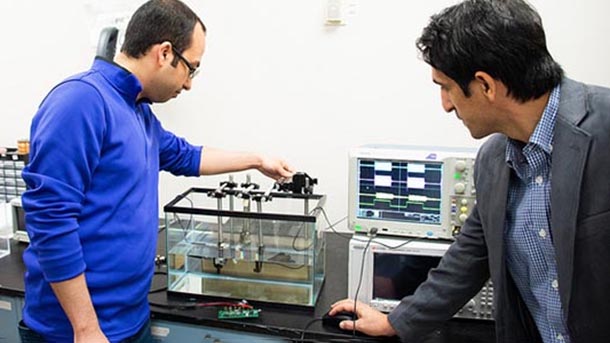
Hesam Sadeghi (left), an electrical engineering graduate student, and Mehdi Kiani, Dorothy Quiggle Assistant Professor of Electrical Engineering, test the ultrasound technology.
Penn State researchers develop new technology to advance ultrasound neuromodulation
11/27/2018
UNIVERSITY PARK, Pa. — When it comes to recording and modulating neurons in the brain, neuroscientists face two options: noninvasive tools with low spatiotemporal resolution, or implantable tools that are highly invasive and can only record or impact a small percentage of the brain’s neurons. Mehdi Kiani, Dorothy Quiggle Assistant Professor of Electrical Engineering, is working to change that.
Kiani, along with co-investigator Susan Trolier-McKinstry, professor of materials science and engineering and electrical engineering, is developing a minimally invasive technology for recording and modulating neurons that would allow for unprecedented large-scale neural stimulation and recording with high spatial resolution.
The short-term applications of this research include being able to more accurately study the brains of animals, such as rodents, who are genetically similar to humans, in order to gain a more precise understanding of the rodents’ brains and, by extension, human brains.
“This research will help us understand how the brain functions at a much larger scale with fine spatial resolutions,” Kiani said. “When we better understand how the brain works, then we can innovate better treatments for brain disorders.”
If proven safe and effective, this research eventually may be used for deep-brain stimulation, which could treat neurological conditions such as Parkinson’s disease, dystonia, epilepsy, depression and obsessive-compulsive disorder.
And the potential benefits do not stop there.
“This technology could be used for brain-machine interface, such as enabling someone to move a prosthetic arm by basically converting thought into action,” Kiani said. “It could also be used for different brain-research applications. For example, memory could be studied by modulating the brain.”
The technology will include a fully wireless implant that rests on the surface of the brain instead of in the tissue, as current invasive models do. It will then be able to ultrasonically stimulate brain regions with the help of an external wearable unit. This method will allow for researchers to simultaneously modulate and record neural activity at larger scale and with higher resolution than can be achieved with either the invasive or noninvasive techniques that currently exist.
In the first year of this two-year project, Kiani and Trolier-McKinstry will design and fabricate the two key pieces for this technology. Trolier-McKinstry is developing the ultrasonic transducer array while Kiani is addressing the wireless electronics design, including the application specific integrated circuit (ASIC). In the second year, they will put these pieces together and demonstrate brain stimulation using ultrasound with high resolution results.
“One of the most exciting things about this research for me is the multidisciplinary nature of it,” said Kiani. “When I came up with this idea, I needed a collaborator for the ultrasound transducer and needed the facilities for building the devices. I knew I’d have all the resources here at Penn State to do it.”
This research is funded by a two-year, $463,417 NIH BRAIN Initiative grant.

